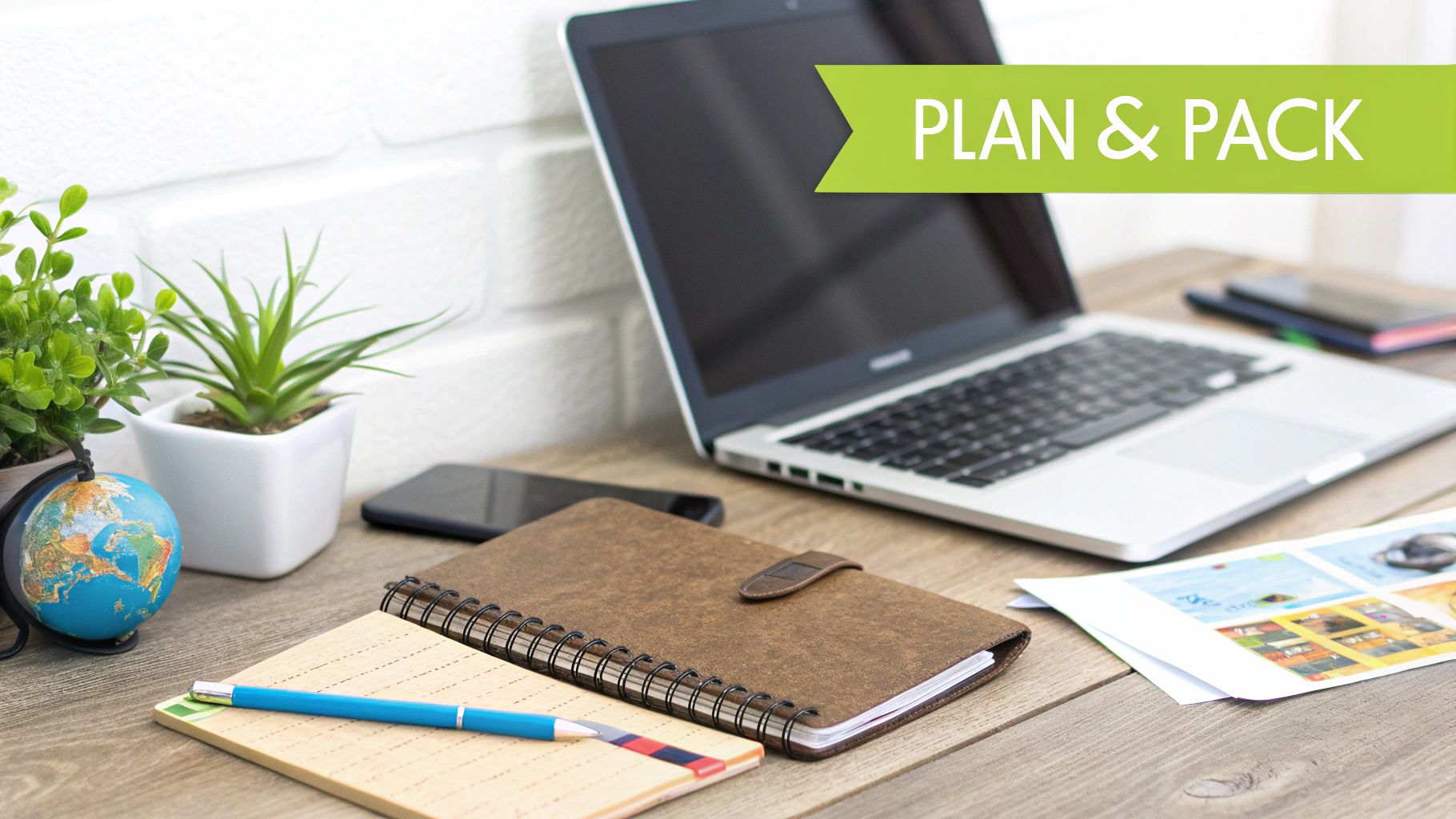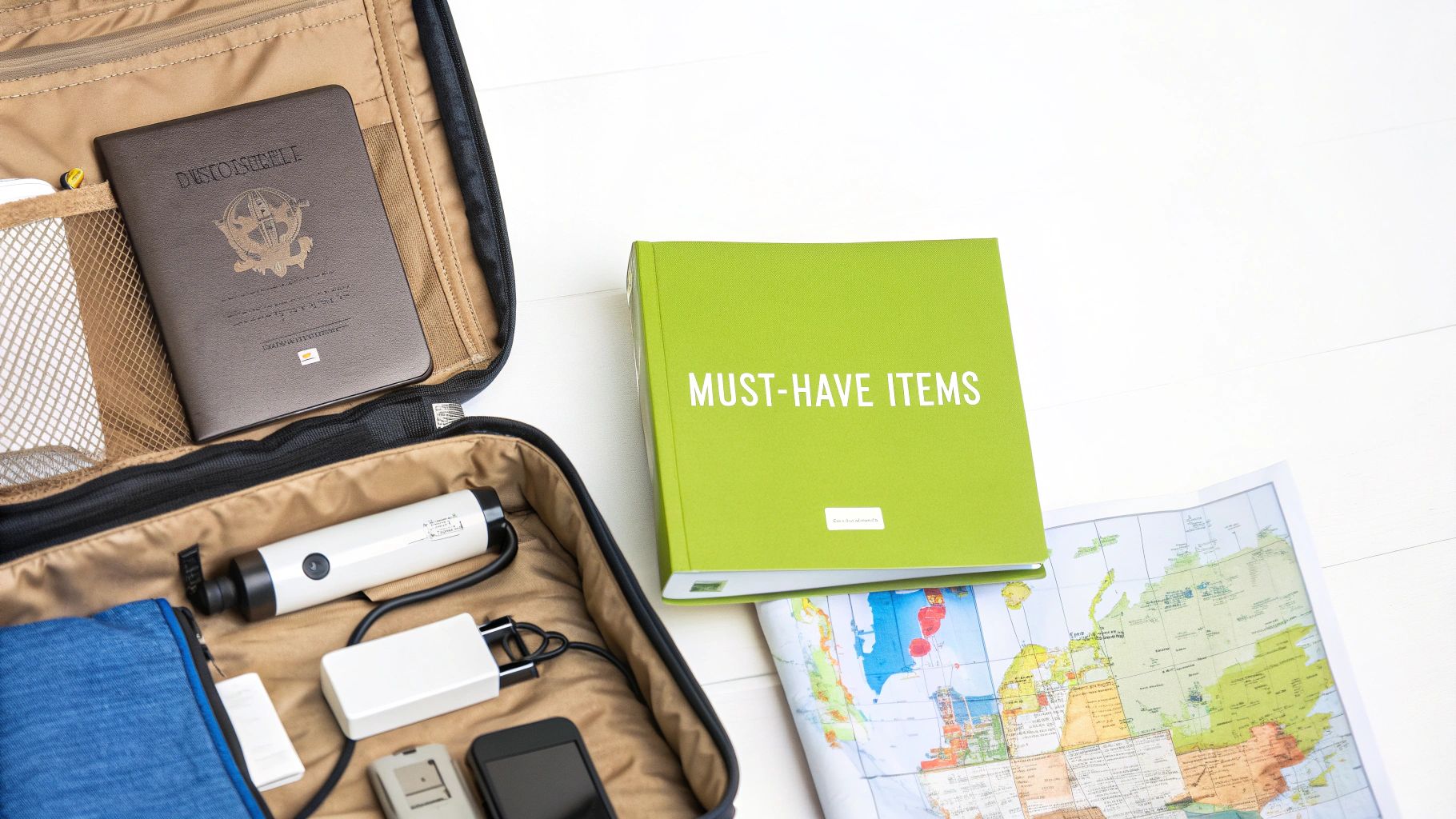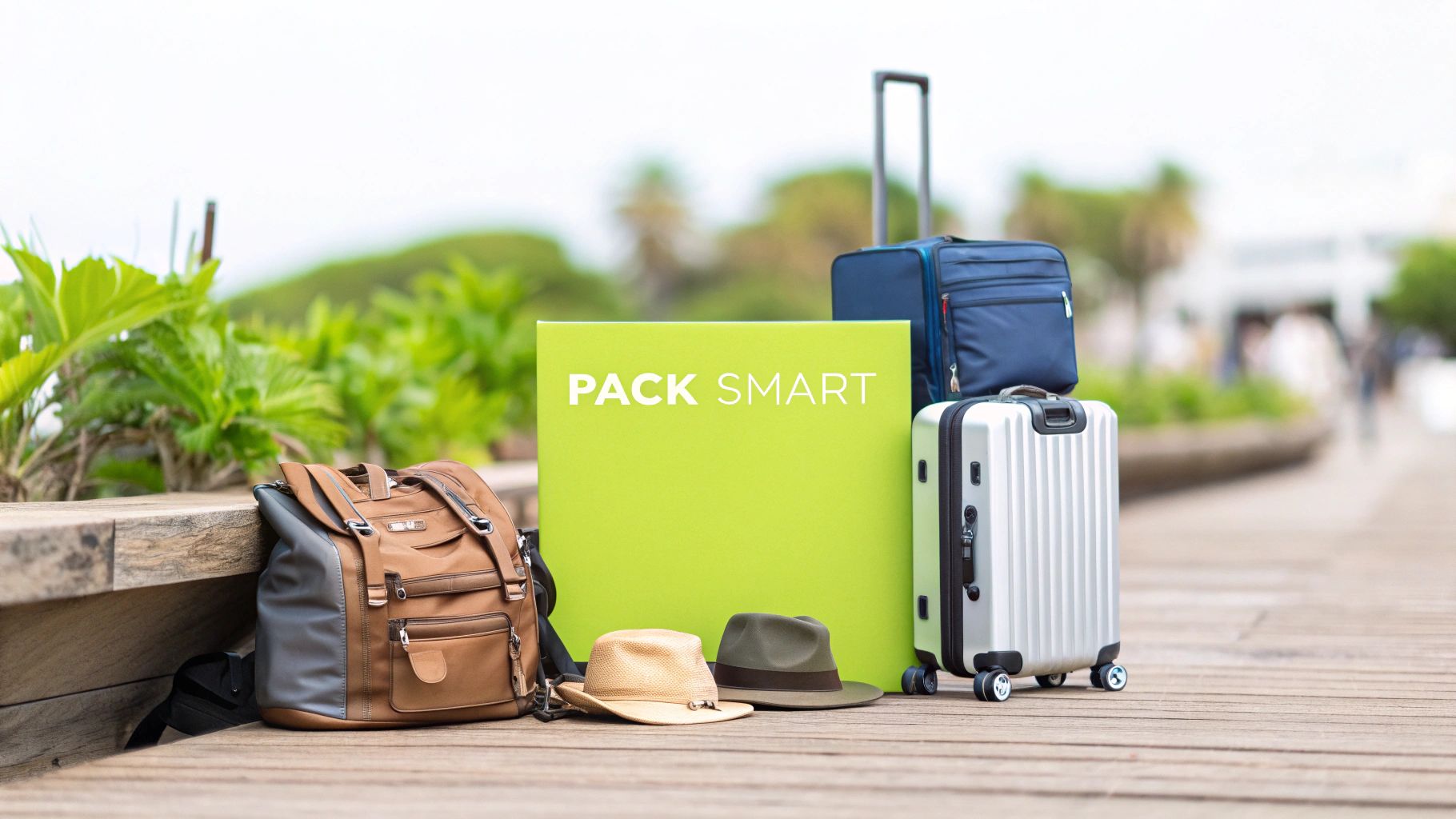Why Smart Travelers Create a Packing List

The key to stress-free travel often lies in a simple packing list. This pre-trip ritual is more than just remembering your toothbrush. It’s a crucial step that sets the stage for a positive travel experience. Planning and organization can significantly reduce pre-travel anxiety.
Creating a packing list helps you focus on the excitement of your upcoming adventure, not the worry of forgetting something.
The Benefits of a Well-Crafted Packing List
A well-crafted packing list has several advantages. It helps you avoid the dreaded "did I forget something?" panic. This panic can derail even the most meticulously planned itineraries.
A good list also helps minimize overpacking. This saves valuable luggage space and helps you avoid potential baggage fees. It ensures you pack appropriate clothing and gear for your destination’s climate and planned activities.
Digital vs. Paper: Choosing the Right System
The best packing list is the one you’ll consistently use. Some prefer a handwritten list. Others find digital packing list apps more convenient. Digital lists offer features like automatic syncing and customizable templates. A pen-and-paper list can be just as effective, especially for those who prefer a simpler approach. Experiment to find what works best for you.
From Chore to Confidence Booster
Creating a packing list doesn't have to be tedious. Approach it strategically, and it becomes a confidence-building exercise. Think of your packing list as a roadmap. As you check off items, you're mentally and emotionally preparing for your journey.
This thoughtful preparation enhances your travel experience. You can focus on making memories, not worrying about forgotten essentials. A well-crafted packing list helps you travel smarter, not harder.
Destination-Driven Packing: Customize Your List

Creating a packing list is more than just tossing items into a bag. It's about customizing your belongings to fit your destination. Seasoned travelers understand the importance of this, carefully researching the climate, local customs, and planned activities. This thoughtful approach helps avoid overpacking and ensures a smooth, enjoyable trip. Think about it: packing for a winter trip to Iceland is vastly different from packing for a summer vacation in Bali.
Researching Your Destination
Understanding your destination is the foundation of a good packing list. Start by researching the weather. Will you need layers for changing temperatures, or will light clothing be enough? You might be interested in: How to master...
Also, research any cultural norms around clothing. Some places may have dress codes for religious sites or public areas. Respecting these customs shows consideration and helps you integrate into the local scene.
Think about your planned activities, too. Hiking in the mountains requires durable boots and performance apparel, while a city break might need more fashionable, adaptable outfits. Logistics matter as well. Consider the capacity of transportation hubs at your destination. If you’re headed to a busy port like Los Angeles, knowing the volume of cargo handled can be helpful. In 2024, the Port of Los Angeles processed over 10.3 million containers. Find more statistics here: https://www.portoflosangeles.org/business/statistics/container-statistics
Frameworks for Different Destinations
Here’s a look at packing essentials for different types of trips:
- Urban Explorations: Comfortable walking shoes, versatile clothing for day and night, and a small daypack for essentials are key. Don't forget a reusable water bottle.
- Beach Getaways: Swimsuits, sunscreen, a hat, and light cover-ups are essential. A beach bag and water shoes are also good to have.
- Mountain Adventures: Pack sturdy hiking boots, moisture-wicking clothing, a rain jacket, and a backpack. Crucial gear like a headlamp and first-aid kit shouldn’t be overlooked.
- Immersive Cultural Experiences: Research local dress codes. Packing a scarf or shawl can be useful for religious sites or dressing modestly.
The following table provides a detailed breakdown of essential items based on your destination type:
Essential Items by Destination Type
A comprehensive comparison of must-pack items based on different destination types
| Destination Type | Climate Considerations | Must-Have Items | Optional Items | Items to Avoid |
|---|---|---|---|---|
| Urban Explorations | Varying temperatures, potential rain | Comfortable walking shoes, versatile clothing, daypack, reusable water bottle | Umbrella, small backpack | High heels, excessive jewelry |
| Beach Getaways | Sunny, hot, humid | Swimsuits, sunscreen, hat, cover-ups | Beach bag, water shoes, sunglasses | Heavy clothing, formal wear |
| Mountain Adventures | Cold, potential rain/snow, varying temperatures | Hiking boots, moisture-wicking clothing, rain jacket, backpack, headlamp, first-aid kit | Trekking poles, extra socks, water filter | Cotton clothing, flip-flops |
| Immersive Cultural Experiences | Dependent on region, research local customs | Clothing respectful of local norms, scarf or shawl | Phrasebook, local currency | Revealing clothing, disrespectful attire |
This table helps illustrate the importance of tailoring your packing list. By considering the specific needs of each destination, you can pack efficiently and appropriately.
By adapting your packing list to your destination and planned activities, you’ll optimize luggage space and have a more comfortable, less stressful travel experience. This allows you to focus on what truly matters: enjoying your trip to the fullest.
Duration Strategies: How to Create a Packing List That Fits

The length of your trip plays a big role in how you should approach your packing list. A quick weekend trip requires a different strategy than a month-long adventure. This section explores how to tailor your packing list to trips of all lengths, from short getaways to extended travel, ensuring you have everything you need without overpacking.
Weekend Escapes: The Art of Minimalism
For short trips, minimalism is the name of the game. Focus on versatile clothing items that can be mixed and matched. A pair of dark jeans can be dressed up for dinner or worn casually during the day. This lets you create several outfits with fewer pieces. Packing cubes can also help organize and compress your clothing, maximizing space in your luggage.
Week-Long Trips: The Capsule Wardrobe Approach
Week-long trips offer more flexibility. Here, the capsule wardrobe method comes into play. This involves choosing a core group of clothing items that all coordinate. This approach allows for a variety of outfits without the extra baggage. Plan for roughly one outfit per day, plus a few extra items just in case.
Extended Journeys: Planning for Laundry and Resupply
Longer trips bring new packing challenges. You'll need to plan for laundry. Consider packing travel-sized laundry detergent or using laundry services at your destination. This drastically cuts down on the amount of clothing you need to bring. It also prevents you from lugging around dirty clothes.
For consumables like toiletries, calculate how much you’ll need. Travel-sized containers are your friend and can be refilled. You can also purchase toiletries at your destination, especially if you're traveling carry-on only.
Balancing Underpacking and Overpacking
The sweet spot is finding a balance between underpacking and overpacking. Underpacking can lead to unexpected expenses and inconvenience. Overpacking, however, can be a real burden, particularly if you’re moving between locations. Your packing list is a valuable tool. Be honest about your needs and adjust the list based on your trip’s length.
Key Takeaways for Creating a Packing List Based on Trip Length
- Weekend Trips: Pack light, prioritize versatile items, and use packing cubes.
- Week-Long Trips: Use the capsule wardrobe method, planning an outfit a day plus a couple of extras.
- Extended Journeys: Plan for laundry, calculate the amount of toiletries you'll need, and consider buying some supplies after you arrive.
By planning for trips of different lengths, you can make a packing list that fits your specific needs. This lets you enjoy your travels without worrying about too much luggage or forgetting essential items. A well-thought-out packing list is key to stress-free travel, no matter the duration.
Transport-Tailored Lists: Pack for Your Journey Style

Your mode of transport plays a big role in how you should pack. Whether you're traveling by air, road, train, or cruise ship, space and security checks can vary significantly. Understanding these differences will help you pack efficiently and avoid travel headaches.
Air Travel: Mastering Carry-On Limits
Air travel often comes with strict carry-on size and weight limits. These restrictions can change, so it's always best to check with your specific airline before you depart. A carry-on suitcase that meets the current regulations can save you time and baggage fees. Using smaller pouches inside your carry-on can help streamline the security process.
Road Trips: Making the Most of Vehicle Space
Road trips give you more packing freedom. However, space can still be an issue, especially when traveling with others. Soft-sided luggage, like duffel bags, can conform to the shape of your vehicle’s trunk or back seats. Organizing items into categories helps maximize space and makes it easier to find what you need on the go.
Train Journeys: Prioritizing Comfort and Ease
Train travel frequently involves longer journeys, so comfort is essential. A backpack or rolling suitcase with good maneuverability is helpful for navigating narrow aisles. Packing layers of clothing allows you to adjust to varying temperatures, ensuring a comfortable trip regardless of the weather.
Cruise Vacations: Packing for Every Occasion
Cruise vacations often involve a mix of activities, from casual days to formal evenings. Plan for both types of attire. Don't forget your swimsuit and other items for enjoying the ship's amenities.
Multi-Modal Travel: Staying Organized on the Go
Journeys involving multiple modes of transport can be tricky. Think about flying to a city and then taking a train to your final stop. Packing cubes or compression bags are great for these trips. They help organize items and save space, making it easy to transfer between planes, trains, or automobiles.
Creating a packing list also means considering transportation more broadly, even from a cargo perspective. Maritime transport, for example, is vital for world trade. The Maritime Administration (MARAD) provides data on vessel activity at U.S. ports.
Security Regulations: Ensuring Smooth Transitions
Be mindful of TSA and international security regulations for liquids and restricted items. These rules can affect your packing choices, particularly for carry-on luggage. Packing light makes security checks and transfers between transportation much easier.
Adaptable Packing Systems: The Key to Stress-Free Travel
Think of your packing list as a work in progress. Seasoned travelers adapt their lists for each trip. For example, if you’re renting a car after a flight, a collapsible duffel bag that fits inside your suitcase can be useful for road trip storage.
By adapting your packing strategy to your mode of transport, you can ensure a smoother, more enjoyable travel experience. A well-planned packing list provides peace of mind, allowing you to focus on your upcoming adventures.
Cultural Considerations: Pack With Global Awareness
Packing for an international trip goes beyond just remembering your passport and toothbrush. It's about demonstrating cultural sensitivity and respect for the places you visit. What you pack sends a message, and this section explores how to create a packing list that reflects global awareness.
Researching Local Customs
Different cultures have different expectations about clothing. Some may require modest dress, especially at religious sites. Researching these customs beforehand will help you avoid unintentional missteps. For instance, in some cultures, revealing attire can be considered disrespectful. Packing adaptable items like scarves or shawls allows you to adjust your clothing easily and show respect for local traditions.
Also, think about the activities you’ll be doing. Will you be attending a special ceremony? Is there a specific dress code? Understanding these details ensures your packing list aligns with the cultural context of your trip.
Region-Specific Essentials
Certain items can be particularly useful depending on where you're traveling. A universal adapter is essential for international travel, allowing you to use your electronic devices regardless of the local outlets. A reusable water bottle is another practical and environmentally friendly item, especially in areas where bottled water is scarce or unsafe.
Even our packing habits can be influenced by cultural factors. The increasing diversity brought about by global migration shifts, such as those following the Immigration and Nationality Act of 1965, has impacted how people pack. You can learn more about the influence of immigration on cultural practices here: https://huggingface.co/datasets/amilmshaji/multillm-route-instruct2/viewer
Items to Leave at Home
What you don't pack is just as crucial as what you do pack. Certain items can be offensive or inappropriate in other cultures. Clothing with religious or political slogans, for example, can be easily misinterpreted. Expensive jewelry might also draw unwanted attention in certain areas. Researching these sensitivities in advance will help you prevent potentially awkward or unsafe situations.
Respectful Travel Through Thoughtful Packing
Packing with global awareness is key to respectful travel. It shows consideration for the local culture and allows you to engage more meaningfully with your destination and its people. By researching customs and packing appropriately, you transform your packing list into a tool for a more authentic travel experience. It allows you to truly connect with a place, not just visit it.
Digital Tools That Transform How You Create a Packing List
Packing can be a real headache. Thankfully, digital tools are here to help streamline the process and make preparing for your next adventure much more efficient. These apps and online resources offer various features, whether you're a seasoned globetrotter or planning a weekend getaway. They can even help you coordinate packing for group trips.
Packing List Apps: Your Pocket-Sized Travel Companion
With so many packing list apps available, there's bound to be one that fits your specific needs. Some apps provide pre-populated templates for different trip types, like business trips, backpacking adventures, or weekend getaways. This can save you a lot of time and effort. Others offer real-time weather updates and suggest clothing accordingly. For instance, PackPoint integrates with weather forecasts to recommend appropriate attire. Many apps also include collaboration features, which are invaluable for family vacations or group trips, allowing multiple users to contribute to a single packing list.
Spreadsheet Software: Customizable and Collaborative
Using spreadsheet software like Google Sheets or Microsoft Excel is another surprisingly effective way to create packing lists. You can customize categories, add personal notes, and even use formulas to calculate the total weight of your luggage. This helps avoid those pesky baggage fees and prevents overpacking. You can also color-code items by category or priority. Plus, sharing and collaborating on a spreadsheet is easy, making it a good choice for group travel planning.
Dedicated Travel Planning Platforms: Integration and Efficiency
Some travel planning platforms, such as TripIt, offer built-in packing list functionality. This integration is particularly useful for managing all aspects of your trip in one convenient location – flights, accommodations, daily itineraries, and, of course, your packing list. Keeping everything centralized helps you see how your packing needs relate to your other travel details.
Choosing the Right Digital Tool for You
The ideal digital packing tool depends on your personal preferences and travel style. If you value simplicity and pre-designed templates, a dedicated packing list app might be the best option. For those who crave customization and detailed organization, spreadsheet software provides greater flexibility. If you already use a comprehensive travel planning platform, using its integrated packing list feature can streamline your travel management process. Read also: How to master...
To help you choose, here's a comparison of some popular packing list apps:
To help you choose, let's compare some popular packing list apps:
Top Packing List Apps Comparison
Detailed analysis of the most popular packing list applications with features and ratings
| App Name | Platform | Key Features | Price | User Rating | Best For |
|---|---|---|---|---|---|
| PackPoint | iOS, Android | Weather integration, trip templates | Free, Premium available | 4.5 stars | Travelers who want weather-based recommendations |
| Packing Pro | iOS | Customizable lists, item sharing | Paid | 4.0 stars | Organized travelers who appreciate detailed control |
| EasyPack | Android | Pre-made lists, offline access | Free | 4.2 stars | Travelers who prefer simplicity and offline use |
This table showcases the variety of apps available, highlighting the different features and pricing options. Consider what's most important to you – weather integration, customization, price, or offline access – when making your decision.
Building a Personalized Digital Packing Database
Once you’ve selected your preferred digital tool, you can start building a personalized packing database. Begin by creating a master list of everything you usually pack, categorized by type (clothing, toiletries, electronics, documents, etc.). For each new trip, you can then copy and modify this master list, adding or removing items as needed. This approach is a significant time-saver, eliminating the need to start from scratch every time. Your digital database will become a valuable resource for future trips, helping you remember essential items and refine your packing strategy over time.
Professional Packing: Business Travel and Logistics
Creating a packing list for business travel demands a more strategic approach than packing for a vacation. It's about presenting a professional image while ensuring you have the tools for productivity on the go. This means carefully considering your attire, technology, and essential documents.
Business Attire: Projecting Professionalism
Your clothing choices are crucial for making a strong first impression. Pack versatile items suitable for meetings, conferences, and client dinners. Consider a suit or blazer, dress pants or skirt, and several dress shirts or blouses. Neutral colors that can be mixed and matched maximize outfit options while minimizing packed items. Don't forget accessories like a professional watch and comfortable, yet stylish shoes.
Essential Technology and Documents: Staying Connected and Prepared
Having the right technology is vital. Your laptop, phone, and charger are obvious necessities. Consider a portable charger for backup power, especially during long flights or meetings. A presentation clicker can be invaluable when giving presentations.
Organized documents are also essential. A travel document organizer keeps your passport, boarding passes, and other important papers secure and accessible. Digitize essential documents whenever possible to reduce paper clutter and ensure you have backups.
Shipping and Logistics: Streamlining The Process
For professionals in shipping and logistics, creating a packing list takes on added complexity. It’s about ensuring accuracy, efficiency, and regulatory compliance. A standardized packing list template can greatly improve workflow and reduce errors.
This template should include:
- Product name and description
- Quantity
- Weight and dimensions
- Customs information (if applicable)
- Handling instructions
In international trade, historical data provides valuable insights for efficient logistics. The Bureau of Transportation Statistics offers historical Transborder Freight Data.
Contingency Planning: Preparing For The Unexpected
Even with meticulous planning, things can go wrong. Experienced business travelers always have a contingency plan. Pack a backup outfit in your carry-on, in case your checked luggage is delayed. Digital copies of essential documents stored in the cloud are crucial if physical copies are lost or damaged. Check out our guide on How to master...
Mastering Professional Packing: Tips For Success
Here are key takeaways for a business travel packing list:
- Prioritize versatile clothing items for mixing and matching.
- Ensure your technology is charged and ready.
- Keep important documents organized and secure.
- Have a contingency plan for unexpected issues.
By mastering these strategies, you'll create a packing list that keeps you organized, productive, and professional on the road, allowing you to focus on achieving your business objectives.
Ready to upgrade your business travel? Explore the Titantrek vacuum compression backpack at https://titantrekstore.com and discover how efficient packing can improve your next trip.

How to Pack for International Travel: Expert Tips
Common Travel Bag Problems and Their Solutions